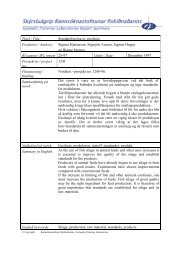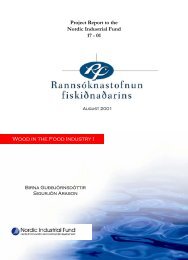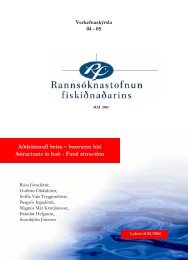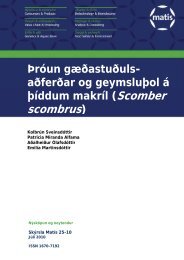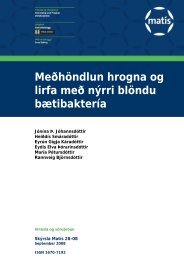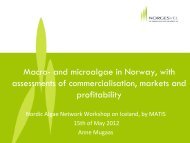Microbiology and Spoilage Trail in Nile Perch (Lates niloticus), Lake ...
Microbiology and Spoilage Trail in Nile Perch (Lates niloticus), Lake ...
Microbiology and Spoilage Trail in Nile Perch (Lates niloticus), Lake ...
You also want an ePaper? Increase the reach of your titles
YUMPU automatically turns print PDFs into web optimized ePapers that Google loves.
conditions which will ma<strong>in</strong>ta<strong>in</strong> the cold cha<strong>in</strong>. The shelf life can be extended if storage is at<br />
super chill<strong>in</strong>g conditions < 0 o C unlike the 0-3 o C used for this trial. Storage at sub zero<br />
temperatures (-2 <strong>and</strong> -3 o C) is reported to <strong>in</strong>crease shelf life (Riaz-Fatima et al., 1988 <strong>and</strong><br />
Sivertisvik et al., 2003; Huss 1995; Chang et al., 1998).<br />
The TVB-N changes were parallel to changes <strong>in</strong> the spoilage micro flora above. However<br />
the TVB-N changed from approximate 7-11mgN/100g which is well below the maximum<br />
acceptability to temperate water fish of 30-35mgN/100g, (Rehbe<strong>in</strong> <strong>and</strong> Olchlenschlager,<br />
1982; Connel, 1995; Huss, 1988).<br />
5.3.2.3 Establishment E3 (6 days iced whole <strong>Nile</strong> perch)<br />
The estimated storage life was 13 days. It is <strong>in</strong>terest<strong>in</strong>g that these results show shelf life that<br />
is close to that of the fillets from the whole fish that was stored longer <strong>in</strong> ice or for 10 days.<br />
The spoilage flora was characterised by very short lag phase <strong>and</strong> dom<strong>in</strong>ated by a log phase<br />
for 2-13 storage days <strong>and</strong> resulted <strong>in</strong> a stationary phase (≥ 8-9 log10 cfu/g) after 13-17<br />
storage days. Similar results was reported by Gram et al. (1989) <strong>in</strong> contam<strong>in</strong>ated<br />
(Pseudomonas) <strong>Nile</strong> perch fillets with counts from 10 8 -10 9 cfu/g after 10 storage days that<br />
rema<strong>in</strong>ed constant dur<strong>in</strong>g the rest of the storage time. Refer also to 5.2.2.1 <strong>and</strong> 5.3.2 above.<br />
Remarkably the TVB-N changes rema<strong>in</strong>ed constant for the first 13 storage days<br />
(6mgN/100g) <strong>and</strong> f<strong>in</strong>ally <strong>in</strong>creased to approximately 11mgN/100g at the end of storage. As<br />
previously the TVB-N (5.3.1.3 above) is low compared to the maximum limits 30-<br />
35mgN/100g. Accord<strong>in</strong>gly it was not good quality <strong>in</strong>dicator for fillets dur<strong>in</strong>g storage at<br />
chill conditions, see 5.2.2 .2 <strong>and</strong> 5.3.2 above. The same can be said for the pH shift from<br />
6.8 to 7.3 units.<br />
5.3.2.4 Establishment E4 (5 days iced whole <strong>Nile</strong> perch)<br />
Storage time was estimated approximately 10-13 days. Changes <strong>in</strong> both spoilage micro<br />
flora <strong>and</strong> chemical TVB-N gave similar trends as mentioned before <strong>in</strong> 5.2.2.2. The TVB-N<br />
slowly <strong>in</strong>creased from 5-13mgN/100g as described <strong>in</strong> 5.3.2 above.<br />
67




